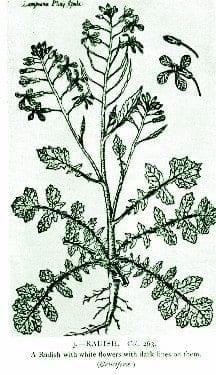Raphanus sativus – Brassicaceae Family
Radish root may be a gift in the garden but radish seeds are what Chinese physicians list among their favorite herbs. In Traditional Chinese Medicine (TCM), it is important to balance the qi to maintain good health. Radish seed invigorates patients with deficient qi otherwise known as low energy or vitality.
The seed is collected in summer when the pods are ripe. Lai Fu Zi is the Pin Yin (Chinese) name for this medicine. It is offered to patients reporting sluggish digestion, excessive coughing or wheezing and abdominal pain. Lai Fu Zi is often prescribed with Hawthorn berry to balance the yin and yang energy in the energy medians.
Anyone savoring a taste of fresh radish root will recognize the pungent flavor of this popular salad vegetable. One bite reveals its energetic movement even as it tickles the tongue. Radish seed’s short germination time also translates into green heart-shaped leaves appearing above the soil line a week or so after planting.
Every part of the radish is edible. Each part is packed with nutrition from the root to the flower. This hardy vegetable is a storehouse of vitamins, minerals and dietary fiber. Couple this with radish’s power to stimulate digestion and you have a dieter’s best friend. In TCM, radish seed is a common treatment for obesity.
Many varieties of radish, including the famous daikon radish, are proudly displayed on produce shelves of Asian markets. Shoppers who know this plant as a vegetable are quick to add it to their carts. Shoppers who know this plant as an herb enjoy an extra gift that lasts beyond that first tangy nibble.







